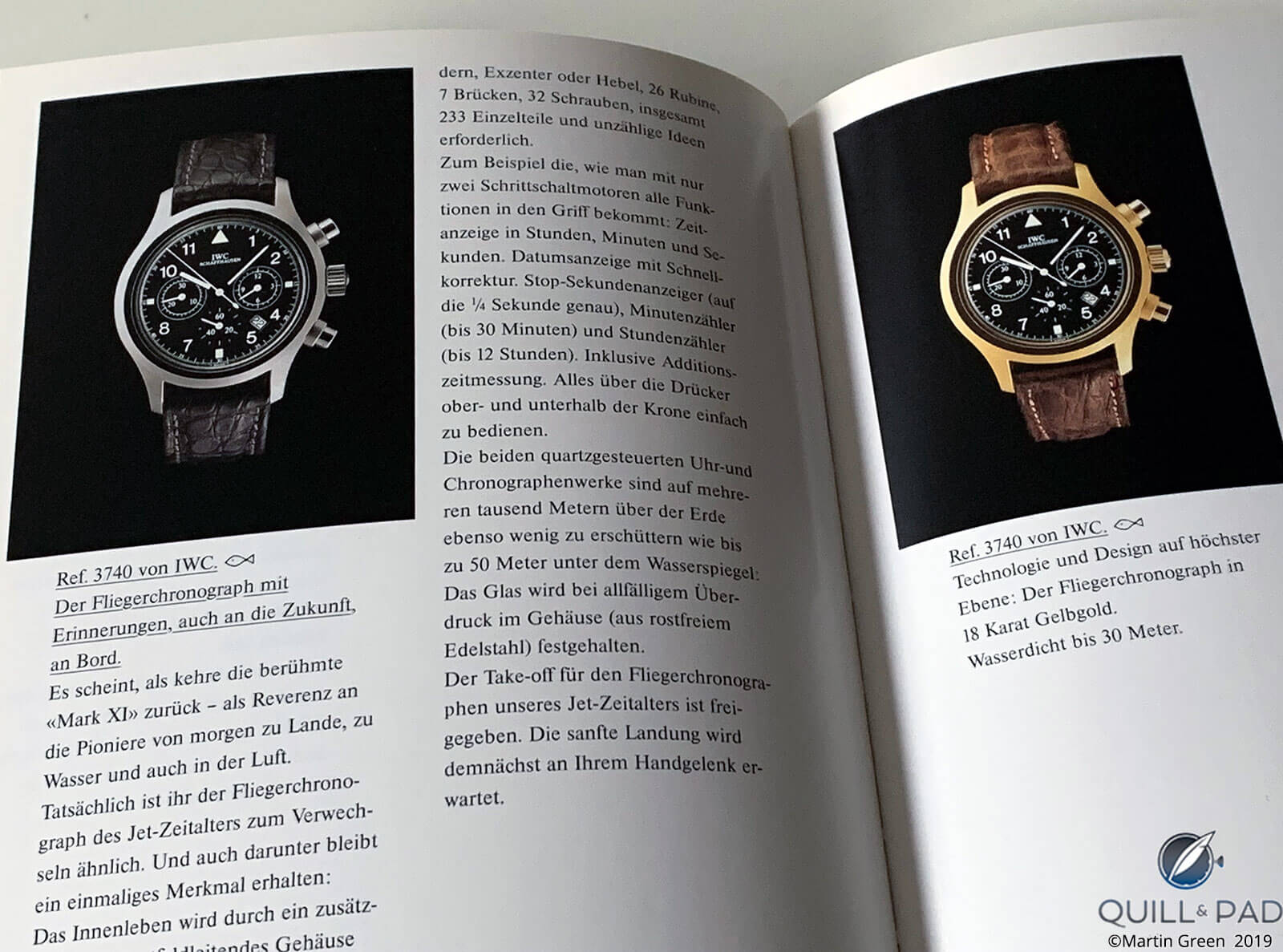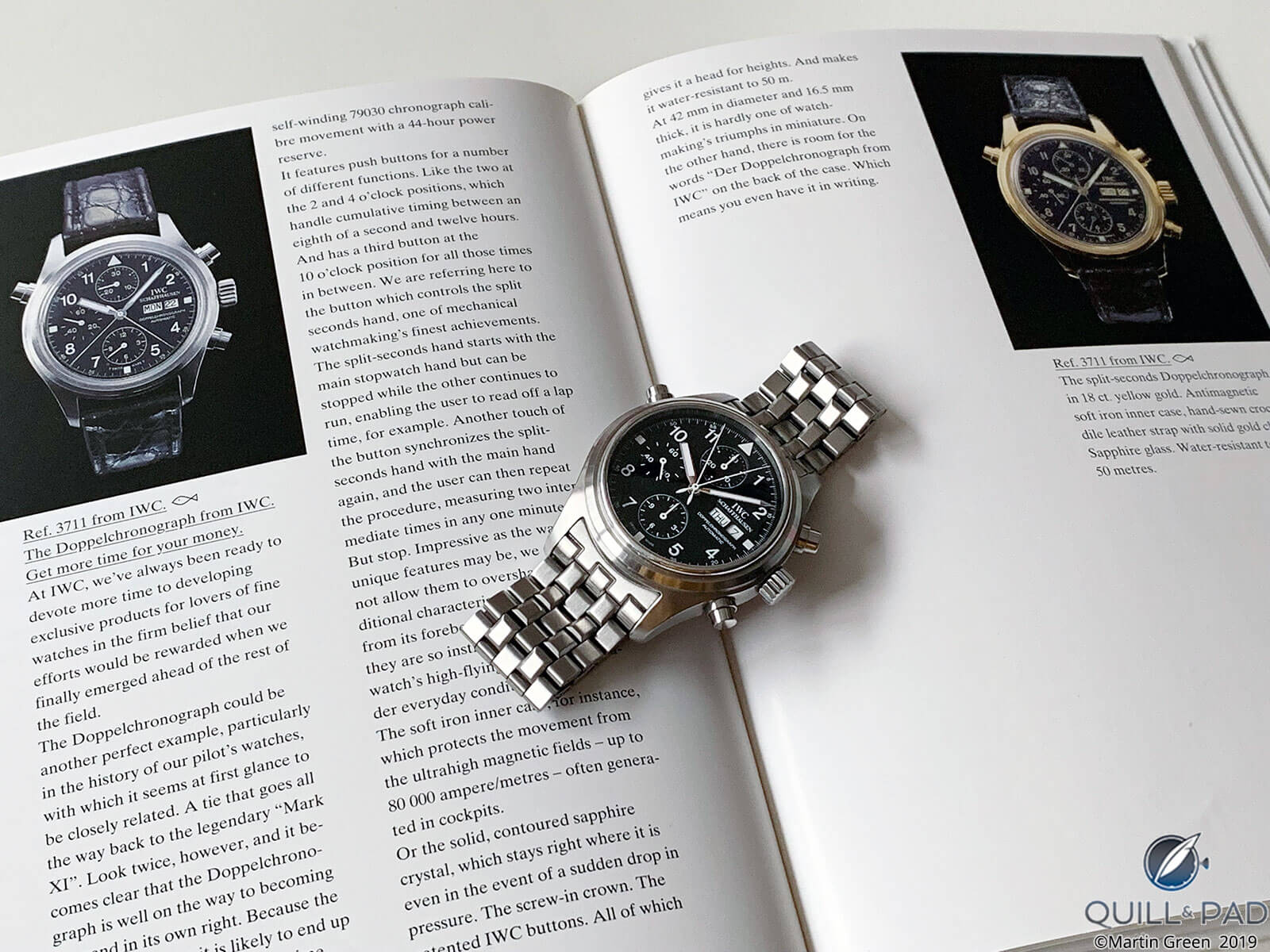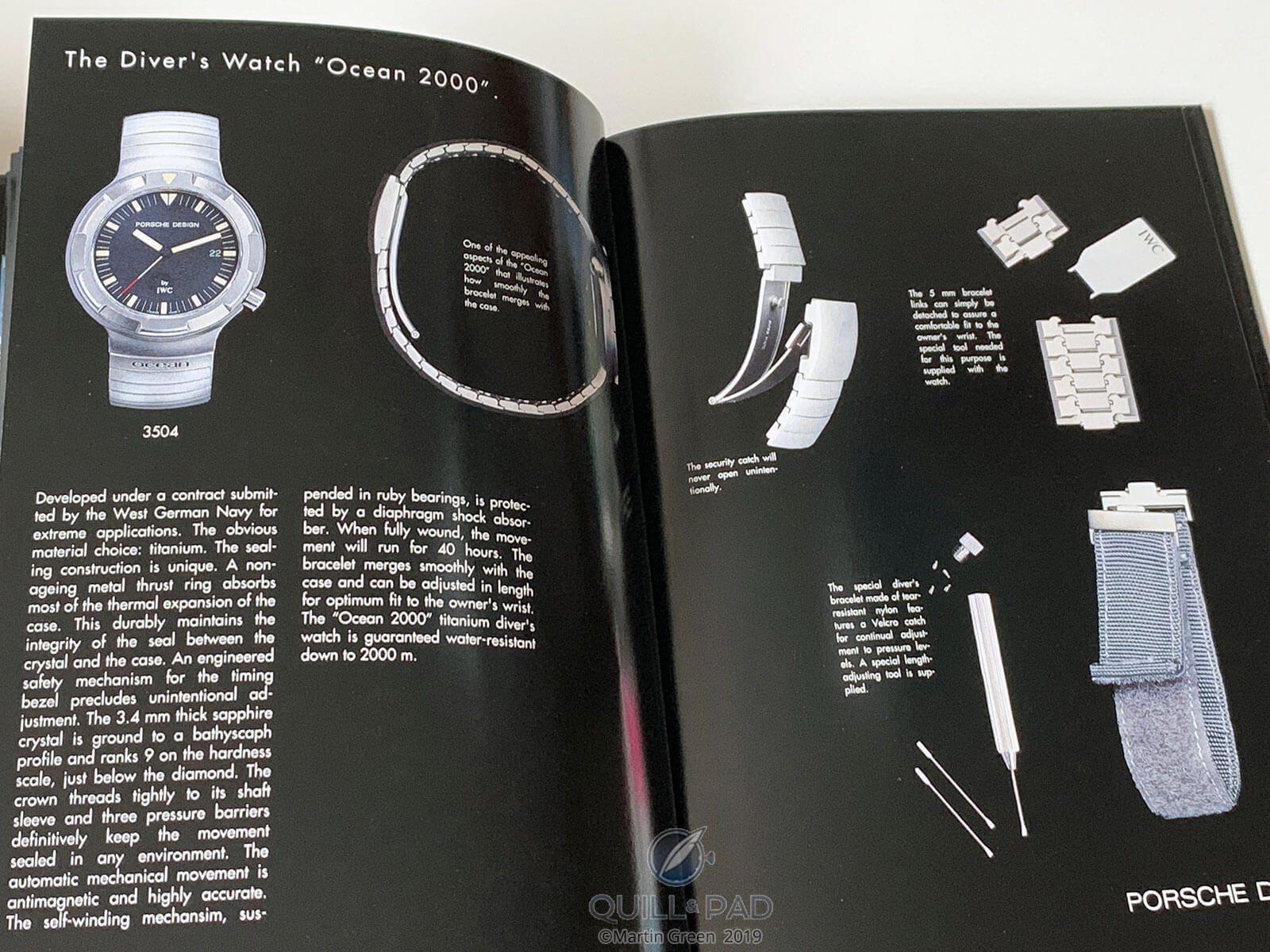by Martin Green
There is no denying it: the watch world is changing. And it is changing fast with brands finding themselves in a constant struggle to keep up and stay relevant.
But the full scope of the effect becomes clear when you look at the brands’ histories. There was a time when the development of most watch manufacturers could be followed quite easily as each year they produced glossy catalogs proudly displaying their offerings – but printed paper catalogs are becoming a thing of the past.
Using three catalogs from IWC – the 1989, 1993, and 1996/97 editions – I note not only the differences between them but also with the current market. It is a journey full of surprises, forgotten watches, unknown treasures, and a shocking realization of how fast “change” has progressed.
IWC catalog of 1989
After the obligatory introduction, an overview of the brand history, and descriptions of the crafts, the IWC catalog of 1989 starts off with the four different ways you can wear your pocket watch! It even shows different chain options for your fob watch.

A how-to-wear-a-pocket-watch guide in the 1989 IWC catalog
After that introduction, it’s not surprising that the following pages feature a vast array of pocket watches, offering everything from relatively simple designs with enamel paintings to skeletonized, gem-set versions. The largest pocket watch features a complete calendar housed in a 200-gram case crafted in 18-karat yellow gold.

Complete calendar skeletonized pocket watch from the 1989 IWC catalog
While it may be surprising to see such an extensive collection, pocket watches have always been important for IWC. The Schaffhausen-based manufacture even boasts several innovations, yet over the years consumer interest in pocket watches rapidly declined. So IWC adapted.
The star of the IWC lineup of 1989 was Kurt Klaus’ masterpiece, the Da Vinci, which combined a perpetual calendar with a chronograph.
IWC also had a small Da Vinci powered by a quartz movement, which combined a moon phase and date with a chronograph in a 32 mm case. In today’s world very few men (if any) would even consider wearing a watch that small, but in 1989 IWC presented this model as perfect for both men and women.

Ceramic Da Vinci in the 1989 IWC catalog
IWC was one of the very first high-end Swiss watch brands to embrace ceramic. Back then ceramic was a young technology still being mastered, so its use was highly exclusive. IWC used ceramic cases for the top-of-the-line Da Vinci in the late 1980s.

The 1989 IWC catalog featured an explanation on how ceramic watch cases were made
Combined with yellow gold hooded lugs, crown, and pushers it might look dated now, but how different things were back then. While the black version enjoys some familiarity among many watch connoisseurs, the white version is lesser known and also looks surprisingly contemporary.
Today an important part of the IWC collection is the Pilot’s Watch line, yet the 1989 catalog features only one model: the quartz Fliegerchronograph in either stainless steel or 18-karat yellow gold.

Only one Pilot’s Watch in the 1989 IWC catalog: the quartz Fliegerchronograph in either stainless steel or 18-karat yellow gold
Sports watches, including the Fliegerchronograph in the Ingenieur collection, are outnumbered by the dress watches and even the pocket watches.
And although the majority of those are made of steel, their relatively small diameters would have most men today probably admiring them but not too keen on actually wearing them.
This catalog also holds a hidden gem: the Novecento, a charming collection of rectangular watches with automatic movements and perpetual calendars. The Novecento combines elegance with masculinity in a way a gentleman would appreciate.

The Novecento collection in the 1989 IWC catalog
Compared with the watches IWC makes today, the Novecento seems like an unlikely creation. While it may be just that, the different functions of the perpetual calendar (with year indication) are beautifully spaced out on the dial. The Novecento is a classic proposition on a leather strap and a very rich-looking watch when fitted with the supple yellow gold or platinum bracelet.
IWC catalog of 1993: pocket watches, Il Destriero Scafusia, and Pallweber
The year 1993 was important for IWC as the manufacture celebrated its 125th anniversary. That makes this catalog perhaps even more interesting as the brand celebrated its 150th anniversary in 2008, and the differences between the two anniversaries are striking.
In 1993, IWC was owned by VDO Adolf Schindling AG and helmed by the capable Günter Blümlein. Blümlein was not only a manager with vision, he also had a true passion for watchmaking. And both become clear from the watches in this catalog.

IWC Il Destriero Scafusia in IWC’s 1993 catalog
An anniversary year calls for a celebration, and IWC responded with Il Destriero Scafusia, the “warhorse of Schaffhausen” grand complication.
As was already customary in those days, Il Destriero Scafusia was a limited edition, just 125 pieces. Due to the complexity of the watch, IWC could only make about two each month, so it took more than five years to finish the series.
Il Destriero Scafusia combines a tourbillon with a rattrapante chronograph, minute repeater, and perpetual calendar – the latter taking advantage of the ingenious perpetual calendar module Kurt Klaus originally developed for the Da Vinci in addition to the solution Richard Habring devised for incorporating a rattrapante complication in the Fliegerchronograph, turning it into the Doppelchronograph.

The Doppelchronograph from the 1993 IWC catalog
This also indicates that the base movement for the Il Destriero Scafusia is the same as the Da Vinci and the Doppelchronograph, the ETA Valjoux 7750. While using such a “pedestrian” base movement would be unheard of today, that was not frowned upon in the 1990s as full manufacture movements were then quite rare.
Technically and aesthetically, Il Destriero Scafusia was the more complicated version of the Grande Complication IWC launched in 1990, which lacked both the rattrapante and tourbillon elements.
Il Destriero Scafusia was not the only watch with which IWC marked its jubilee year; it also released a limited edition of the Portugieser dedicated to the history of the model and fitted with the beautiful manual winding Caliber 9828.
As IWC also highlights its extensive history in this catalog, we find a picture of the digital pocket watch with Pallweber movement here that 25 years later would be the highlight of the Jubilee collection dedicated to IWC’s 150th anniversary.
It is interesting to note that even in 1993 about 10 percent of the entire IWC catalog is dedicated to pocket watches. Not to highlight its history or craftsmanship – if that had been included the pocket watch section would have taken up an even higher percentage of the publication – but to showcase the different models available. Collectors were apparently still buying pocket watches in smaller, but significant, numbers
The Pilot’s Watch collection featured Reference 3711 – better known as the Doppelchronograph. With a diameter of 42 mm it was a beast at the time, yet one boasting a very tempting split-seconds chronograph. The beauty of this watch lies in its simplicity, clean dial design, and very reliable movement.
The clean design still has a lot of interesting details, especially the gold version. IWC even designed the background color of the day and date wheels to match to the tone of this metal.
However, in terms of sports watches, was it the Ingenieur that demanded the limelight. IWC offered it as an “officially certified chronometer” (with a very interesting typo on page 116, proclaiming it an “officially certified chronograph”).
The Ingenieur was offered in steel with a steel bracelet or leather strap, steel with gold, and full gold. Additionally, there was also a quartz chronograph with alarm as part of the Ingenieur lineup, using a movement supplied by Jaeger-LeCoultre.
At the back of the catalog, IWC also offered several books, among them The Grande Complication by IWC by Manfred Fritz. This book is an interesting read, but for those who found it a bit too plodding, IWC also offered it as a 20-minute movie on a VHS cassette.
How times have changed!
Porsche Design supplement
The slipcase of the 1993 catalog had a supplement highlighting watches designed by Porsche Design and made by IWC. This collaboration resulted in a very impressive lineup of watches, beginning with the chronograph that was the world’s very first watch crafted in titanium. What is perhaps even more striking is that its design still looks thoroughly modern.

IWC Ocean 2000
The same can be said of the Ocean 2000, a legendary diver’s watch that was water resistant to 2,000 meters, which came on an innovative bracelet as well as a velcro diving strap. While the Ocean 2000 was definitely a luxury product, we shouldn’t underestimate the tool element of this watch: IWC delivered several to the Bundeswehr (“German Federal Armed Forces”), who used them on active duty.

Porsche Design for IWC featuring titanium watch cases
Another Porsche Design icon, made by IWC, is also presented here: the “compass watch” could tell you the time, but when you pulled up the case holding the automatic movement, you found a handy compass complete with snap-up sapphire crystal mirror underneath.
The compass watch was also crafted in titanium – a truly high-tech creation for its time!
IWC catalog of 1996/1997
This particular IWC catalog from 1996/1997 came from the Zurich airport, where the city’s most eminent, and unfortunately now defunct, jeweler Türler had an outlet. The layout of this catalog isn’t much different than that of the previous two, still highlighting aspects of IWC that are familiar, but also a few that might be unfamiliar – especially to more recently interested watch enthusiasts.
Interesting here is the Da Vinci Rattrapante, a watch IWC introduced on the tenth anniversary of its perpetual calendar, giving the watch its tenth hand to indicate the split-second function.

IWC Da Vinci Rattrapante
What is unique about the Da Vinci Rattrapante is that it is basically the integration of the work of three brilliant minds: Edmond Capt (responsible for the design of the Valjoux 7750 base movement); Kurt Klaus (who designed the innovative perpetual calendar module); and Richard Habring, who developed the rattrapante function.
In today’s world, the Da Vinci Rattrapante remains a very tempting piece, combining a few of the most loved complications in a single watch.
The late 1990s was also the time of the Mark XII. Time flies when you’re having fun: today we are already at the Mark XVIII. Compared to that, the Mark XII is modest in terms of size and appearance, bearing a close resemblance to the Mark XI.
The Doppelchronograph and Fliegerchronograph are also featured in this catalog, with the latter now also available in a black ceramic case giving the watch a high-tech, perhaps even a bit sinister, look before that became fashionable.

Skeletonized IWC Reference 2701
Illustrating just how much IWC has changed over the years (like the industry), we see a stunning skeletonized watch, Reference 2701, which would be hard to imagine in the brand’s current catalog. Reference 2701’s refined elegance is something that is unfortunately a hard sell in today’s market, which is why IWC discontinued it.

IWC Portofino Perpetual Calendar from the 1996/97 catalog
The same might be said of the Portofino Perpetual Calendar. Also a very subtle design, with clear indications of its calendar functions, making it the perfect choice for a gentleman who was looking for an understated piece with technical prowess. And the same can be said of the Novecento and Venezia, two designs that you would expect more from a brand like Cartier than IWC.
Yet they are part of the heritage of the latter, which was still going strong in 1996/1997. The Venezia is even fitted with a shaped movement, Caliber 1822.
Both are stunning creations, but IWC has always been a brand to look forward rather than backward. While IWC greatly respects its own heritage, the brand knows that its clients don’t like it to dwell on the past, but rather use it as an inspiration to create the future.
The IWC illustrated by these three catalogs is long gone, yet at the same time not gone at all as today’s collection could have never been created without it.
You may also enjoy:
Valjoux 7750: The World’s Greatest Chronograph Movement By Far (By Popularity And Numbers)
Leave a Reply
Want to join the discussion?Feel free to contribute!





















































Yay those pocket watches! I just started wearing some of mine again after about 20 years wrist only. At 52 years, I’m solidly presbyopic, and the larger watch held at arm’s length is the perfect solution to what had become an annoying blur on my wrist. AND others half my age and even less think my little chain is smart fashion, then are blown away when I show them what I carry on the end of it in my vest or pant’s fifth pocket.
Awesome Nathaniel! thank you so much for sharing!